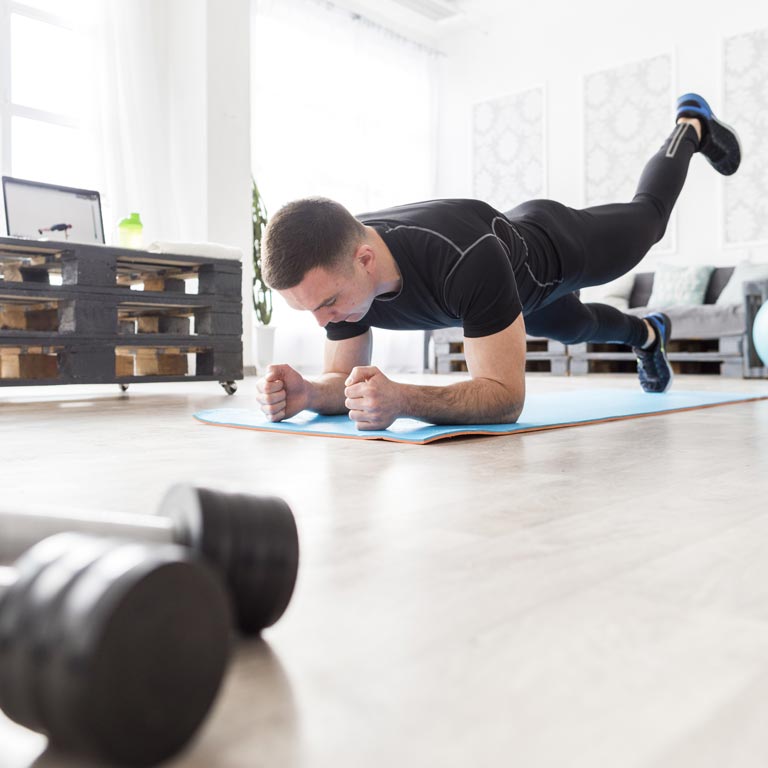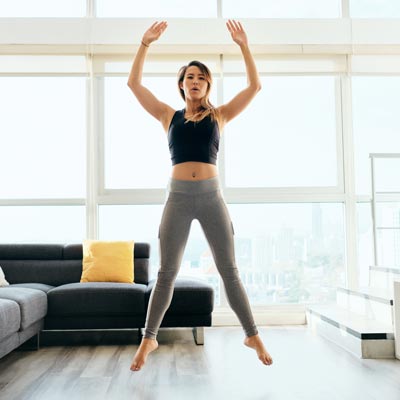
Exercises to maintain muscle mass
Due to the situation that has arisen from the state of alert that has led to confinement in homes without being able to go outside, staying active and exercising can be more difficult. Even more so if you are a regular sportsperson and maintain good muscle tone, these days you may worry about losing it or you may have doubts about what to do to maintain your muscle mass.
Muscles need continuous movement, otherwise they can run the risk of losing mass and weakening our agility, flexibility and locomotion skills.
That is why we would like to present you with a series of recommendations so that you do not lose your tone, muscle mass and flexability during lockdown.
Home exercises during lockdown
In general, Physical Activity guidelines recommend 150-300 minutes per week of moderate-intensity aerobic exercise and 2 sessions per week of muscle training. So even if you can't reach those numbers with 15-20 minutes of physical activity now, you are gaining in health and positive thinking.
Here are some recommendations for both regular exercisers and athletes:
- Create your own space to exercise, with good light, ventilation and the music you enjoy.
- Organize those elements that allow you to exercise, such as a skipping rope, elastic straps, dumbbells (you can improvise some with packages of vegetables, rice or water bottles), mats or blankets, if you have a fixed bicycle, etc.
- If you normally go to a gym or have a trainer, you can keep in touch with them virtually so that they can continue to guide your exercise routine.
- Motivate others through social networks with your exercise routine or follow live workouts or videos.
- Make an agenda for your physical activities, and measure your results to motivate you to continue.
What aerobic exercises can I do at home?

- Dance to your favorite music or exercise to a video.
- Jump rope (skip) with at least 12 repetitions.
- With your favorite music, walk quickly around the house or up and down the stairs for at least 15 minutes, twice a day.
- Two great aerobic exercises besides cardio are Jumping Jacks and knee fifts, which you can do alternately for 30 to 60 seconds, repeating twice. Jumping Jacks consist of jumping up with your legs and arms outstretched at the same time, and the second one consists of raising your knees with your feet outstretched and your arms straight and free, keeping your torso straight and tense.
What muscle training exercises can I do at home?
- There are many applications that you can download to your electronic devices, as well as video exercise routines. The recommendation is that these routines last at least 7 minutes so that they are moderately intense and help maintain your muscle mass.
- The same goes for the videos from muscle strength and endurance experts that you can find on the internet and practice them in the space you have created for your workout.
- Yoga is a discipline that connects body, mind and breathing, since through the physical postures you maintain your tone and muscle mass, which complemented with breathing exercises definitely improves your overall body tone.
- Exercises such as squats, wall push-ups, sit-ups, lunges and crunches are ideal for keeping your muscles in shape. Each exercise can be practiced in a complete routine of at least 30 seconds each by repeating at least 3 sets.
If you have training equipment at home, the following are the ones that can best increase muscle mass, shown from the highest to the lowest:
- Free weights
- Weight machine
- Total training system
- Suspension belts
- Russian weights
- Resistance bands
- Medicine balls
Routine for muscle tone during lockdown
In general, it is recommended that for training or exercise routines to maintain muscle tone, especially during confinement, the following actions be performed:

- Dynamic warm up: prepares the body for activity by stimulating blood flow and movement through a wide range of motion. The best exercises are those that increase the heart rate such as jumping or pedaling a stationary bike, followed by exercises to move the joints such as arm rotation.
- Active cooling down: aimed at minimizing muscle fatigue and soreness because after exercise, blood flow decreases and cellular waste products can build up. A good way is to pedal on a stationary bike at a slower pace for 5 or 10 minutes at the end of the workout.
- Stretching and mobility: focused on attending to the trained muscles, to avoid tension or fatigue, after finishing the exercise. To keep the tendons and muscles mobile, it is recommended to stretch each muscle group for at least 60 seconds. All stretching and mobility exercises should be completed in a slow and controlled manner, while breathing during each exercise.
- Work on the stressed areas with a foam roller: if you have one at home, gently roll it on the affected body part, approximately a couple of centimeters per second for about 30 to 60 seconds in total. Slowly increase the pressure as tolerated and work on the areas that feel tight or sore. Avoid rolling directly over the bones and joints or spending too much time in one area.
- Massage and recovery: This can be a recovery strategy, especially to reduce muscle pain and fatigue experienced after exercise. It should always be done after exercise with sessions of at least 20-30 minutes and use vegetable oils that facilitate working with the hands. It is always advisable to use vegetable oils on the skin, to prepare it so that your hands gently roll over the muscle. Arnica oil is a good choice for this relaxing massage session.
To help your muscles, keep in mind these two recommendations: eat right for your calorie-burning regimen in order to maintain your weight and include protein in your diet.
Take action for your physical and mental health!





